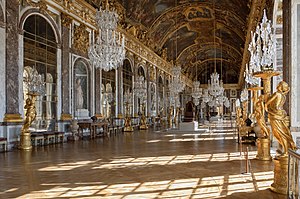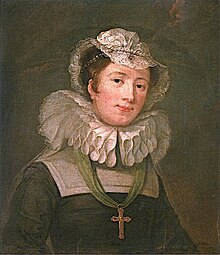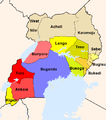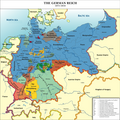Portal:Monarchy
Portal maintenance status: (June 2018)
automated editing software. Learn how to update the maintenance information here . |
The Monarchy Portal  A monarchy is a form of government in which a person, the monarch, is head of state for life or until abdication. The political legitimacy and authority of the monarch may vary from restricted and largely symbolic (constitutional monarchy), to fully autocratic (absolute monarchy), and can span across executive, legislative, and judicial domains. The succession of monarchs has mostly been hereditary, often building dynasties. However, elective and self-proclaimed monarchies have also often occurred throughout history. Aristocrats, though not inherent to monarchies, often serve as the pool of persons from which the monarch is chosen, and to fill the constituting institutions (e.g. diet and court), giving many monarchies oligarchic elements. Monarchs can carry various titles such as emperor, empress, king, and queen. Monarchies can form federations, personal unions and realms with vassals through personal association with the monarch, which is a common reason for monarchs carrying several titles. Monarchies were the most common form of government until the 20th century, by which time republics had replaced many monarchies. Today forty-three sovereign nations in the world have a monarch, including fifteen Commonwealth realms that share King Charles III as their head of state. Other than that, there is a range of sub-national monarchical entities. Most of the modern monarchies are constitutional monarchies, retaining under a constitution unique legal and ceremonial roles for the monarch, exercising limited or no political power, similar to heads of state in a parliamentary republic. (Full article...)
| ||||||||||||||||||||||||||||||||||||||||||||||||
 |
| Credit: Myrabella |
The
Did you know (auto-generated)
More Did you know...
- ... that Andreas Frederik Krieger (pictured) was one of the most vocal critics of the morganatic marriage between Frederick VII of Denmark and Louise Rasmussen?
- ... that King Henry VIII, was executed for treason?
- ... that the Moika Palace, a museum about the murder of Grigori Rasputin (pictured) by Prince Felix Yusupov, was also the scene of the homicide?
More did you know facts |
 Good articles - load new batch
Good articles - load new batch
-
Image 1Portrait by William Hogarth, 1759
Mary Woffington Cholmondeley (1729 – 4 April 1811) was an Irish socialite of the Georgian era. Her sister was the famous actor Peg Woffington. After a failed attempt at an acting career, Mary married the second son of the Earl of Cholmondeley and chose to live as a socialite. With connections in both English and French high society, she came to have a "modest salon", and was close friends with Frances Burney and Samuel Johnson. (Full article...) -
Image 2Battle of Cape St Vincent. Shortly after that battle, Nelson took part in the Battle of Santa Cruz de Tenerife, where the attack failed and he lost his right arm, forcing him to return to England to recuperate. The following year he won a decisive victory over the French at the Battle of the Nile and remained in the Mediterranean to support the Kingdom of Naples against a French invasion. (Full article...)Image 3Middle Persian: 𐭥𐭫𐭧𐭫𐭠𐭭), was the Sasanian King of Kings (shahanshah) of Iran from 388 to 399. He was likely the son and successor of Shapur III (r. 383–388).)
Before his accession to the throne, Bahram served as governor of the southeastern province of Kirman. There he bore the title of Kirmanshah (meaning "king of Kirman"), which would serve as the name of the city he later founded in western Iran. (Full article...Image 4Laelianus (r. 269), as they share the same nomen, and perhaps from Dacia, where the name was common. It is not known when she married Aurelian, but it might have been before he became emperor. She was probably proclaimed Augusta in the autumn of 274.)
Aurelian was murdered in September/October 275 and his successor, Tacitus, was proclaimed emperor only after a brief interregnum, lasting somewhere between five and eleven weeks. Though coins of Severina were minted under Aurelian from 274 to 275, some historians speculatively assign certain unusual types of coins to this brief interregnum period and suggest that Severina either effectively briefly ruled the empire in her own right, or that there was confusion in regards to Aurelian's successor until Tacitus became emperor, and coin mints thus chose to mint coins in Severina's name. Given that no literary source discusses Severina, any interpretation of the unusual coins remains speculation. (Full article...Image 5king of Babylon as a vassal of the Neo-Assyrian Empire from 668 BC to his death in 648. Born into the Assyrian royal family, Šamaš-šuma-ukin was the son of the Neo-Assyrian king Esarhaddon and the elder brother of Esarhaddon's successor Ashurbanipal. (Full article...)Image 6absolute monarch from 1768 until his death. Of unclear origins, Šćepan became the ruler of Montenegro through a rumour that he was in fact the deposed Russian emperor Peter III, who had died several years before Šćepan surfaced in the Balkans.)
Šćepan arrived in Montenegro in the autumn of 1766. Whether Šćepan was his real name is unknown, as is the reason for the epithet Mali. Who started the rumour that Šćepan was Peter and why is also unclear. Šćepan himself never formally proclaimed himself to be Peter, but never denied it either. Throughout 1767, he offered vague hints that he was the dead emperor, and as time went on, most of Montenegro became convinced of his supposed identity. Although Montenegro's legitimate ruler, Prince-Bishop Sava, who had met the real Peter and had received word from the Russian ambassador in Constantinople that Peter was dead, attempted to expose Šćepan, most Montenegrins continued to believe the rumours. In 1767, Šćepan was proclaimed as the country's ruler, and in February 1768, Sava was sidelined and confined to his monastery. Šćepan subsequently assumed the powers of an absolute monarch. (Full article...Image 7bailli), and was left to defend the city against the ruler of Epirus, Theodore Komnenos Doukas. Left unsupported by the Latin Empire, and with a projected crusade to relieve the city delayed, he surrendered the city in December 1224. The belated arrival of the crusade helped to save his own fief from falling to the Epirotes, however, and he was soon able to return there, dying on or shortly after 1237. (Full article...)Image 8Fars after the death of his childless uncle Imad al-Dawla, after which Rukn al-Dawla became the senior emir of the Buyids. In 974 Adud al-Dawla was sent by his father to save his cousin Izz al-Dawla from a rebellion. After defeating the rebel forces, he claimed the emirate of Iraq for himself, and forced his cousin to abdicate. His father, however, became angered by this decision and restored Izz al-Dawla. After the death of Adud al-Dawla's father, his cousin rebelled against him, but was defeated. Adud al-Dawla became afterwards the sole ruler of the Buyid dynasty and assumed the ancient Iranian title of Shahanshah ("King of Kings"). (Full article...)Image 9William Montagu from the Salisbury Roll, c. 1463. He displays the Montagu arms (modern) Argent, three fusils conjoined in fess gules on his breastplate, whilst his maternal arms of de Montfort (Bendy of eight or and azure) are shown on a shield at left.
William Montagu, alias de Montacute, 1st Earl of Salisbury, 3rd Baron Montagu, King of Man (1301 – 30 January 1344) was an English nobleman and loyal servant of King Edward III.
The son of William Montagu, 2nd Baron Montagu, he entered the royal household at an early age and became a close companion of the young Prince Edward. The relationship continued after Edward was crowned king following the deposition of Edward II in 1327. In 1330, Montagu was one of Edward's main accomplices in the coup against Roger Mortimer, who until then had been acting as the king's protector. (Full article...)Image 10Roman Catholic rulers. Onneca was a member of the Íñiguez dynasty, named after her great-grandfather Íñigo Arista, who founded the Kingdom of Pamplona.)
Information about Onneca's life is limited. Biographical details about her come from two main sources: the Códice de Roda and the accounts of Muslim Andalusi historians, who refer to the grandmother of Abd al-Rahman III by the Arabic name Durr (در), meaning "pearl". Her marriage created family ties between the Roman Catholic and Muslim ruling families of the Iberian peninsula, initially leading to close collaboration between the Catholic House of Íñiguez and the Muslim Umayyads. The political effects resulting from Onneca's marriages continued to be felt long after her death, which occurred at an unknown date. (Full article...Image 11Serbia and Bosnia, terminating the zone of buffer states along the southern frontiers of the Kingdom of Hungary. Matthias signed a peace treaty with Frederick III in 1463, acknowledging the Emperor's right to style himself King of Hungary. The Emperor returned the Holy Crown of Hungary with which Matthias was crowned on 29 April 1464. In this year, Matthias invaded the territories that had recently been occupied by the Ottomans and seized fortresses in Bosnia. He soon realized he could expect no substantial aid from the Christian powers and gave up his anti-Ottoman policy. (Full article...)Image 12British royal residences. Her education was devised by Prince Albert's close friend and adviser, Christian Friedrich, Baron Stockmar, and included practical activities such as needlework and woodwork and languages such as French and German. When her father became fatally ill in December 1861, Alice nursed him until his death. Following his death, Queen Victoria entered a period of intense mourning and Alice spent the next six months acting as her mother's unofficial secretary. On 1 July 1862, while the court was still at the height of mourning, Alice married a minor German prince, Louis of Hesse. The ceremony—conducted privately and with unrelieved gloom at Osborne House—was described by the Queen as "more of a funeral than a wedding". Alice's life in Darmstadt was unhappy as a result of impoverishment, family tragedy and worsening relations with her husband and mother. (Full article...)Image 13Lorenzo II de' Medici. She helped restore the Medicis to power after they had been exiled. She worked to secure a French royal marriage for her son, and was also influential at the court of Pope Leo X, her brother-in-law.)
Throughout her life, she used her wealth, position, and connections to help the poor and underrepresented. She also used them to further her family's power and wealth. She was a patron of the arts and architecture, both in Florence and in Rome. This included renovation of religious buildings as well as construction of palaces for the family. (Full article...Image 14
Edmund the Martyr (also known as St Edmund or Edmund of East Anglia, died 20 November 869) was king of East Anglia from about 855 until his death.
Few historical facts about Edmund are known, as the kingdom of East Anglia was devastated by the Vikings, who destroyed any contemporary evidence of his reign. Coins minted by Edmund indicate that he succeeded Æthelweard of East Anglia, as they shared the same moneyers. He is thought to have been of East Anglian origin, but 12th century writers produced fictitious accounts of his family, succession and his rule as king. Edmund's death was mentioned in the Anglo-Saxon Chronicle, which relates that he was killed in 869 after the Great Heathen Army advanced into East Anglia. Medieval versions of Edmund's life and martyrdom differ as to whether he died in battle fighting the Great Heathen Army, or if he met his death after being captured and then refusing the Viking leaders' demand that he renounce Christ. (Full article...)Image 15caliph of the Abbasid Caliphate from 870 to 892. His reign marks the end of the "Anarchy at Samarra" and the start of the Abbasid restoration, but he was largely a ruler in name only. Power was held by his brother al-Muwaffaq, who held the loyalty of the military. Al-Mu'tamid's authority was circumscribed further after a failed attempt to flee to the domains controlled by Ahmad ibn Tulun in late 882, and he was placed under house arrest by his brother. In 891, when al-Muwaffaq died, loyalists attempted to restore power to the Caliph, but were quickly overcome by al-Muwaffaq's son al-Mu'tadid, who assumed his father's powers. When al-Mu'tamid died in 892, al-Mu'tadid succeeded him as caliph. (Full article...)Featured portrait

Eleanor of Toledo Credit: Bronzino Uffizi Gallery in Florence, Italy. It is the first known state-commissioned portrait to include the ruler's heir, which was done in part because Cosimo's predecessor Alessandro died without any legitimatemale heirs. The boy's inclusion implies that Cosimo's rule would bring stability to the duchy.Selected quote
All in the world I have is yours; Next to God, you are the one I love best, and if I did not know that your love for me is the same, I could not be so happy as I am: May God give us both the grace to live always in this affection without any guile. — William the Silent, to his first wife while she was dying in 1558Related portals
General images - load new batch
The following are images from various monarchy-related articles on Wikipedia.-
Image 1Sri Lankan King Devanampiya Tissa, Queen consort Anula, and Prince Uththiya, c. 307 BC (from Monarch)
-
Image 3Dinzulu kaCetshwayo, the last king of an independent Zulu state, in 1883 (from Non-sovereign monarchy)
-
Image 4Elizabeth II was the monarch of independent countries in Europe, Asia, Africa, Oceania and the Americas. (from Monarch)
-
Image 5From left to right, JapaneseEmpress Nagako, 1959 (from Monarch)
-
Image 6Ramesses II (r. 1279–1213 BC), the third Pharaoh of the Nineteenth Dynasty of Egypt (from Monarch)
-
Image 7Emperor of Brazil, by Delfim da Câmara (from Monarch)
-
Image 8The administrative divisions of the British Protectorate of Uganda, including five of today's six kingdoms (from Non-sovereign monarchy)
-
Image 9The constituent states of the German Empire (a federal monarchy). Various states were formally suzerain to the emperor, whose government retained authority over some policy areas throughout the federation, and was concurrently King of Prussia, the empire's largest state. (from Non-sovereign monarchy)
-
Image 10Emperoroldest continuous hereditary monarchy in the world. (from Hereditary monarchy)
-
Image 11The islands that make up Wallis and Futuna (from Non-sovereign monarchy)
-
Image 12Hawaii (from Monarch)
-
Image 13Photograph of Tsar Alexander II, 1878–81 (from Absolute monarchy)
-
Image 14Contemporary European monarchies by type of succession )
-
Image 15British India and the princely states within the Indian Empire. The princely states (in yellow) were sovereign territories of Indian princes who were practically suzerain to the Emperor of India, who was concurrently the British monarch, whose territories were called British India (in pink) and occupied a vast portion of the empire. (from Non-sovereign monarchy)
-
Image 16A map of Europe exhibiting the continent's monarchies (red) and republics (blue) (from Monarch)
-
Image 17The Nine Sovereigns atKing Frederik VIII of Denmark. (from Monarch)
-
Image 19Emperor of Haiti, 1804 (from Monarch)
-
Image 22Waikato, the homeland of the Māori kings (from Non-sovereign monarchy)
-
Image 24Subdivisions of the United Arab Emirates (from Non-sovereign monarchy)
-
Image 26Postcard from 1908 showing nineteen of the world's reigning monarchs: (left to right)King Alfonso XIII of Spain. (from Monarch)
Featured content
Topics
Type Topics Titles Current Africa Asia Europe - Andorra
- Belgium
- Denmark
- Liechtenstein
- Luxembourg
- Monaco
- Netherlands
- Norway
- Spain
- Sweden
- Vatican City (Holy See)
Oceania Commonwealth realms Former Africa Americas Asia - Afghanistan
- Asir
- Bengal
- Bukhara
- Burma
- Cebu
- Chehab
- China
- Dapitan
- Hejaz
- Indonesia
- Iran (Qajar)
- Iraq
- Jabal Shammar
- Kandy (Sri Lanka)
- Kathiri
- Khiva
- Korea
- Kumul
- Kurdistan
- Laos
- Maguindanao
- Mahra
- Maldives
- Manchukuo
- Mongolia
- Najran
- Nepal
- Qu'aiti
- Ryukyu
- Sarawak
- Shan
- Sikkim
- Sip Song Chau Tai
- Sulu
- Syria
- Tibet
- Taiwan
- Upper Asir
- Upper Yafa
- Vietnam
- Yemen (South Yemen)
Europe - Albania
- Aragon
- Asturias
- Austria
- Austria-Hungary
- Bavaria
- Bosnia
- Brittany
- Bulgaria
- Crimea
- Cilicia
- Corsica
- Cyprus
- Finland
- France
- Galicia
- Georgia
- Germany
- Greece
- Granada
- Hanover
- Hungary
- Iceland
- Imereti
- Ireland
- Italy
- Kartli-Kakheti
- Lithuania
- Majorca
- Man
- Moldavia
- Montenegro
- Navarre
- Neuchâtel
- Ottoman Empire
- Papal States
- Piedmont-Sardinia
- Poland–Lithuania
- Portugal
- Prussia
- Romania
- Russia
- Samos
- Saxony
- Savoy
- Scotland
- Serbia
- Tavolara
- Two Sicilies
- Tuscany
- United Baltic Duchy
- Yugoslavia
- Valencia
- Württemberg
Oceania Commonwealth realms Categories
WikiProjects
- WikiProject Royalty and Nobility
- WikiProject Biography
- WikiProject Commonwealth realms
- WikiProject Politics
Associated Wikimedia
The following Wikimedia Foundation sister projects provide more on this subject:
-
Commons
Free media repository -
Wikibooks
Free textbooks and manuals -
Wikidata
Free knowledge base -
Wikinews
Free-content news -
Wikiquote
Collection of quotations -
Wikisource
Free-content library -
Wikiversity
Free learning tools -
Wiktionary
Dictionary and thesaurus
Discover Wikipedia using portals


























































